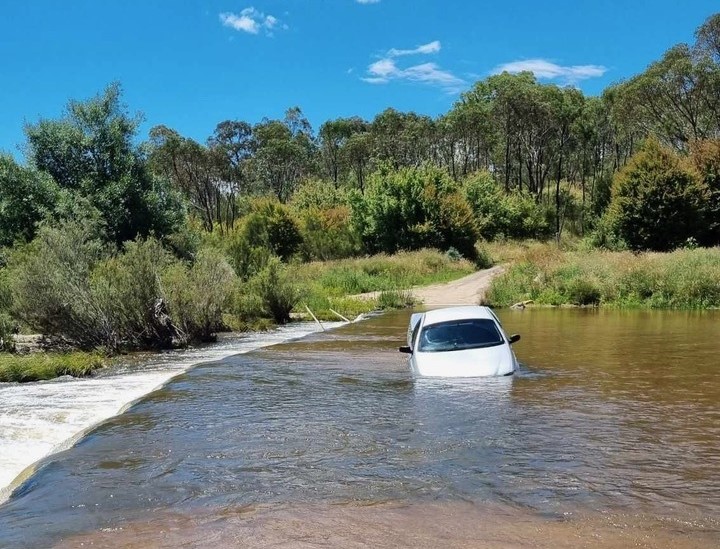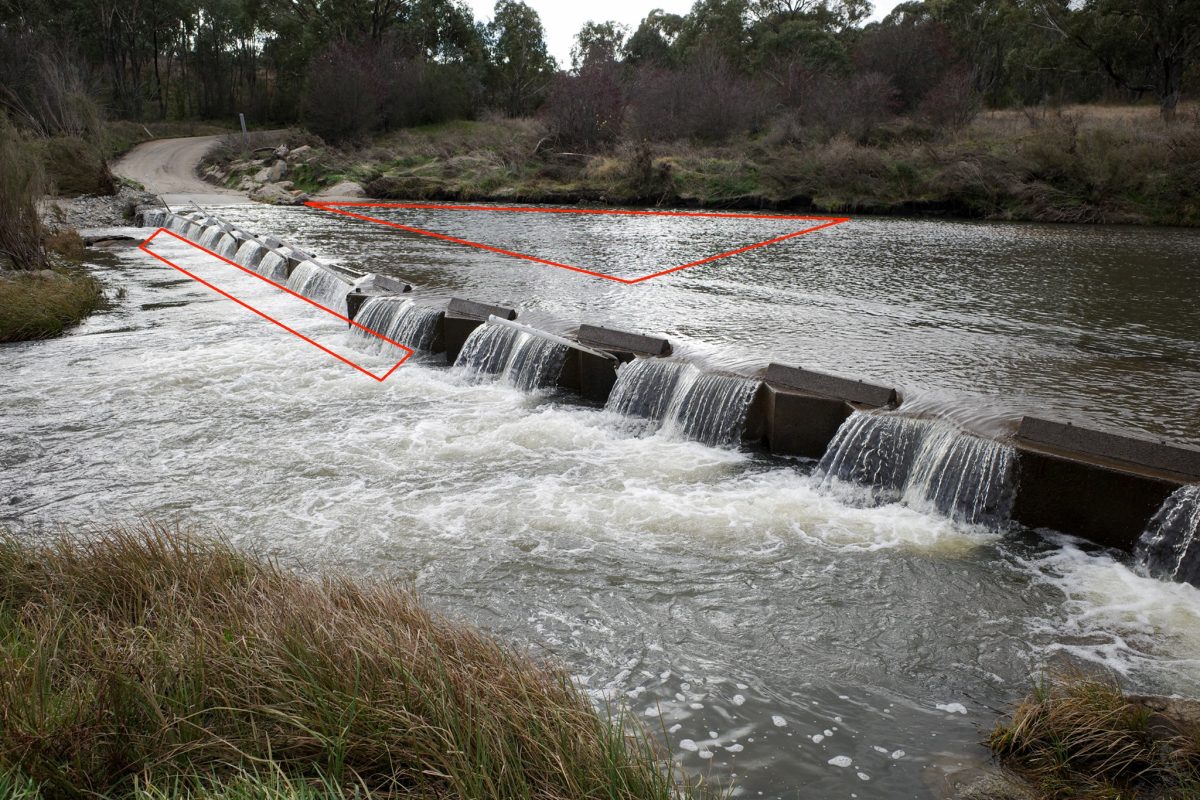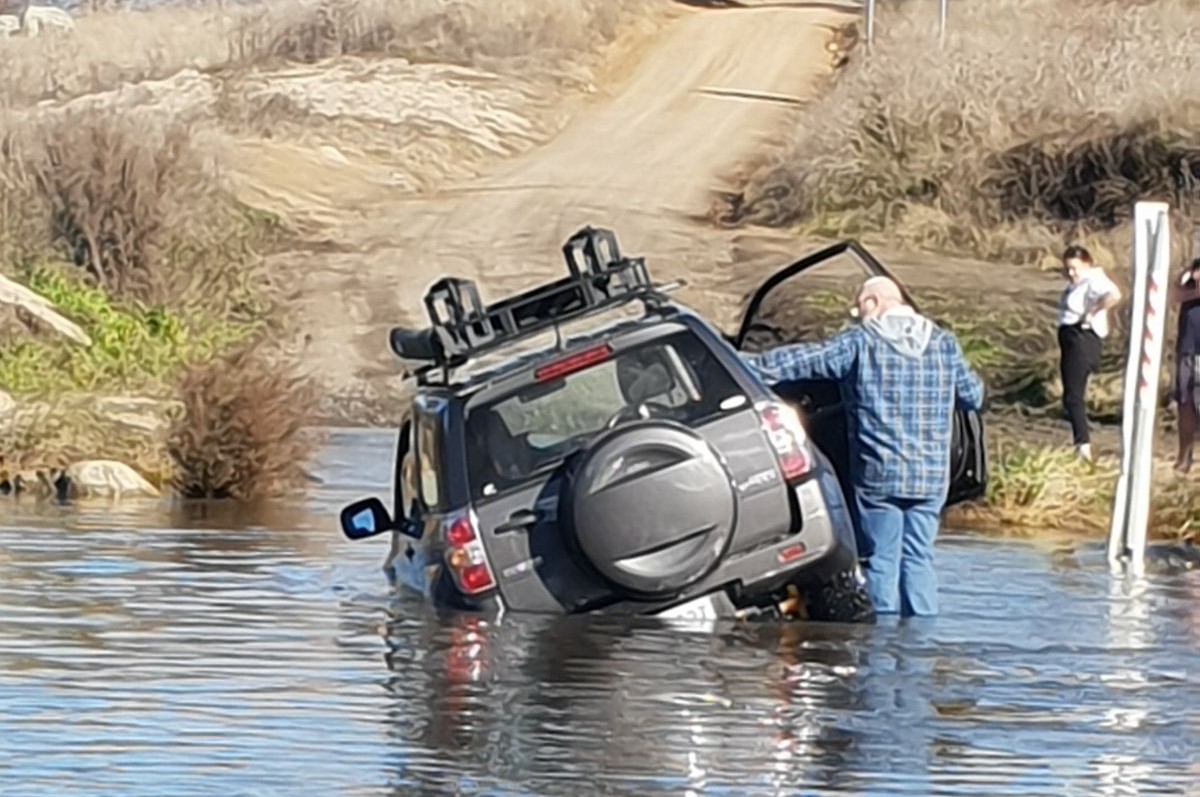
This Ford Falcon ute is one of at least 15 vehicles that have come to grief at the Sunshine Road Crossing. Photo: Dan Sloss.
UPDATE (18 January, 8:15 am): The ACT Government has confirmed plans to improve a low-level crossing near Tharwa with a reputation among the locals for flooding and sending cars over the edge.
A slight bend on Sunshine Road as it crosses the Gudgenby River has caught out more than a dozen vehicles over the years (including a fire truck), when motorists attempt to cross while it’s covered in murky water.
Residents say the culvert beneath the concrete crossing has been clogged with sand since around the time of the 2003 bushfires to the point it’s “never dry” anymore, while vertical markers installed along the edge to help guide motorists have since been washed away.
The ACT Government has received two “enquires” over the last 12 months about the crossing.
It argues the culverts were only designed to take “dry weather flows” and not flood conditions, and that there are guide signs on the approach to the crossing, warning about the risk.
Nevertheless, help is on the way.
“Maintenance work to clear drains and pipes at Sunshine Crossing, which requires environmental clearances which are currently being finalised, are planned,” a government spokesperson told Region.
“It is anticipated that this work will be completed mid-year in 2024.”
For now, the government will inspect the concrete barriers “when water levels allow”. It also reminds motorists to never drive through flood waters, no matter how safe they may appear on the surface.
“Low level crossings are unpredictable during and after rain events as water levels can rise rapidly.”
Sunshine Road has been temporarily closed, along with the nearby Angle Crossing.
17 January, 5 pm: Sunshine Road twists its way through the scrub between Naas Road and Smiths Road, south of the village of Tharwa on the edge of the ACT’s southeast border.
It’s narrow and unsealed, but mostly smooth and uneventful. The trouble arrives at McMahon’s Crossing when it turns to concrete and passes over the Gudgenby River.
Over the years, it’s estimated at least 15 vehicles have fallen off the edge of the crossing after the driver presumed it to be a straight path to the other side. It isn’t – there’s a slight bend midway, but this is nigh invisible when there’s several centimetres of murky water on top.
“When the Gudgenby is flowing – as it has been recently – you really can’t see the road. Drivers look ahead to the other side and drive straight across but miss the fact there’s a kink in the crossing,” says local resident Dan Sloss.
“It’s not an uncommon thing.”
Rumour has it this kink was deliberately engineered into the crossing to prevent heavy articulated vehicles such as logging trucks from navigating it.
Dan says flooding wasn’t really an issue until after the 2003 bushfires when the large concrete pipes designed to carry water safely underneath the crossing became choked with dirt and sand due to erosion upstream.
“It’s never a dry crossing anymore,” he says.
“There’s one person that lives on Sunshine Road, and he’ll sometimes put up the yellow barrier when it’s bad, but people can just drive around the barrier, look at the crossing and think it’s not so deep.”

McMahon Crossing in June 2021: the vertical markers have been bent over. Dan Sloss suggested the ACT Government remove the sand (marked in red upstream) to open the clogged pipes (marked in red downstream) so that water would run through the pipes instead of water running over the top. Photo: Dan Sloss.
All the locals are aware of it, but more and more, it’s catching visitors unaware, including an ACT Fire & Rescue truck on one occasion.
Markers were installed along the edge to guide drivers, but these have been progressively washed away in flood events and never replaced.
According to Dan, there have been “zero roadworks of any kind” to fix the issue, except to fill occasional potholes at either end of the ramp. He says it’s become somewhat of a political football between the NSW and ACT governments due to how close it sits to the border.
“But that should never be an issue, really, because we all share the costs of roads everywhere in the country.”
According to Clive Haggar from the Smiths Road Community Association, McMahon’s Crossing is only the tip of the iceberg.
He was among five families to stake out a home in the village in the 1970s, drawn by the appeal of a rural setting 20 minutes from the conveniences of the Tuggeranong town centre. There are now about 150 residents, and Clive says it’s time the infrastructure received the investment it needs for the population to continue to grow.
The community has lobbied politicians for “years” to have the last few kilometres of Smiths Road sealed, a major thoroughfare for locals that runs over the border. NSW has come to the party, but Clive says it’s been “a bit of a struggle” with the ACT Government.
“The ACT Government committed back in 2011 to bitumen a small section on the ACT side each year, and we’ve been successful in getting a substantial amount of the road done.”

Markers were installed to guide drivers, but these have been progressively washed away in flood events and never replaced. Photo: Dan Sloss.
In 2014, the Gudgenby River was proclaimed tamed when a new reinforced concrete bridge opened on Smiths Road to replace one clogged with debris and partially washed away during floods in December 2010.
“It was fantastic,” Clive says.
“But we still have this stretch of quite dangerous road that’s badly drained and is single-lane in some sections because of washouts.”
The ACT Government was contacted for comment.
This article was originally titled ‘Tharwa residents call for fix to low-level river crossing’.












